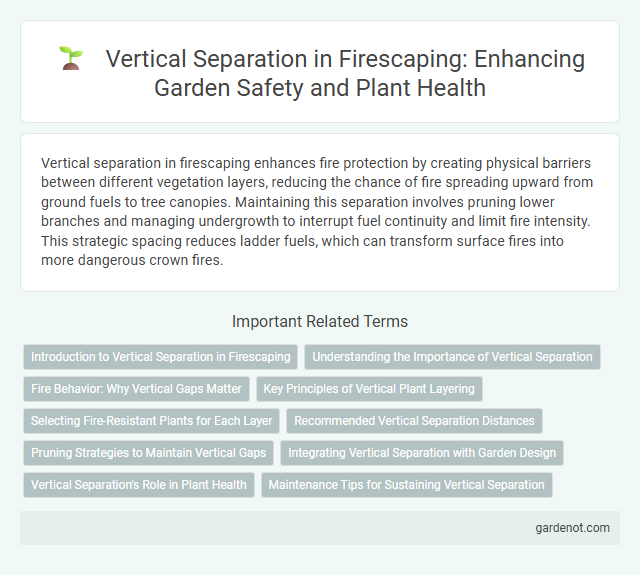Vertical separation in firescaping enhances fire protection by creating physical barriers between different vegetation layers, reducing the chance of fire spreading upward from ground fuels to tree canopies. Maintaining this separation involves pruning lower branches and managing undergrowth to interrupt fuel continuity and limit fire intensity. This strategic spacing reduces ladder fuels, which can transform surface fires into more dangerous crown fires.
Introduction to Vertical Separation in Firescaping
Vertical separation in firescaping is a critical strategy to reduce wildfire risks by creating distinct layers of vegetation and clear spaces between the ground and tree canopies. This approach limits flame spread and reduces the likelihood of crown fires by interrupting fuel continuity vertically. Implementing vertical separation involves pruning lower branches, removing ladder fuels, and maintaining adequate spacing between understory plants and overstory trees to enhance fire resilience.
Understanding the Importance of Vertical Separation
Vertical separation in firescaping refers to creating physical distance between different vegetation layers and structures to reduce fire spread and intensity. Maintaining adequate vertical clearance between tree canopies, shrubs, and ground fuels helps prevent flames from climbing upward, thereby protecting homes and property. Effective vertical separation supports firebreaks and enhances defensible space, crucial for wildfire resilience in high-risk areas.
Fire Behavior: Why Vertical Gaps Matter
Vertical separation in firescaping significantly influences fire behavior by interrupting flame spread and reducing radiant heat transfer between vegetation layers. Maintaining adequate vertical gaps between tree canopies and understory plants decreases the likelihood of crown fires, which are more intense and harder to control. Effective vertical separation slows fire progression and enhances firefighter safety by limiting the fire's upward momentum.
Key Principles of Vertical Plant Layering
Vertical separation in firescaping enhances wildfire resistance by strategically layering plants based on height and flammability. Key principles of vertical plant layering include maintaining adequate spacing between ground covers, shrubs, and tree canopies to prevent fire from easily climbing upwards. Using fire-resistant species and ensuring vertical clearance reduces the risk of fire spreading vertically through vegetation.
Selecting Fire-Resistant Plants for Each Layer
Selecting fire-resistant plants for vertical separation involves choosing species with low flammability and high moisture content to reduce fire spread between ground cover, shrubs, and trees. Emphasize planting deciduous trees, succulents, and herbaceous perennials that are less prone to ignition and maintain proper spacing to interrupt fuel continuity. Incorporating these fire-wise plants in each vegetation layer creates effective defensible space and enhances overall property fire resilience.
Recommended Vertical Separation Distances
Recommended vertical separation distances in firescaping are crucial for minimizing fire spread between vegetation layers and structures. Maintaining at least 3 feet of vertical clearance between ground fuels and low-hanging tree branches reduces ladder fuels that facilitate fire escalation. This strategic spacing disrupts vertical fire pathways, enhancing landscape defensibility and protecting properties from wildfire exposure.
Pruning Strategies to Maintain Vertical Gaps
Effective pruning strategies for maintaining vertical separation involve selectively removing lower tree branches and shrubs to create clear vertical gaps between ground fuels and the canopy. This practice reduces the risk of fire laddering by minimizing fuel continuity and limits flame length and intensity during a wildfire. Consistent monitoring and timely pruning improve vegetation health while enhancing defensible space and landscape resilience against fire spread.
Integrating Vertical Separation with Garden Design
Vertical separation enhances firescaping by creating distinct vegetation layers that reduce wildfire spread through strategic height differences. Integrating vertical separation with garden design involves selecting fire-resistant plants at varied heights, incorporating hardscape barriers like rock walls and terraces, and maintaining clear gaps to disrupt flame pathways. This approach not only improves wildfire defense but also adds aesthetic depth and biodiversity to the garden landscape.
Vertical Separation's Role in Plant Health
Vertical separation in firescaping is crucial for reducing fire spread by creating clear zones between ground vegetation, shrubs, and tree canopies. Maintaining adequate vertical distance prevents flames from climbing vegetation layers, thereby protecting plant health and reducing stress caused by heat exposure. Proper vertical separation also promotes better air circulation and light penetration, enhancing overall plant vigor and resilience.
Maintenance Tips for Sustaining Vertical Separation
Regularly prune and thin trees and shrubs to maintain vertical separation between vegetation and structures, reducing fire risk. Inspect and remove dead or overgrown branches that can bridge the gap from ground fuels to higher vegetation layers. Consistent maintenance ensures effective vertical separation, limiting fire spread and protecting buildings from radiant heat and direct flame contact.
Vertical separation Infographic

 gardenot.com
gardenot.com